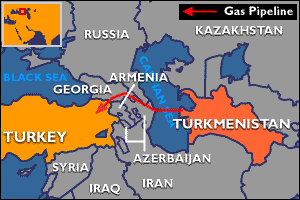Iran’s enigmatic energy exploration in Caspian Sea
Iranian media outlets have reported contradictory information about drilling the second well of a gas field in the Caspian Sea which was reportedly discovered in December 2011.
The Iranian Mehr News Agency reported on September 30, 2012 that the National Iranian Oil Company announced it had begun drilling a second exploratory oil well in the Caspian Sea's deep waters, while a week after this information, head of the Iran's North Drilling Company told Shana that the submersible Amir Kabir rig was moved to another place to drill a second exploratory well in the Sardar-e Jangal gas field in a month.
On the other hand, a European top diplomat anonymously told Trend on Jan.14 that "according to satellite observations, the location of this rig (Amir Kabir) has not changed from December 2011 to December 2012 and no sign of thermal activity was observed above this rig during the aforementioned period".
Iran claims the Sardar-e Jangal field's discovered oil and gas layers hold reserves totalling two billion barrels of light crude oil, 500 million of which is extractable alongside 1.4 trillion cubic meters of gas.
Sardar-e Jangal field's first well reportedly was drilled 700 metres in depth through benthos in 1000-metre deep waters. Iranians said the discovered field is a gas field, then on May 10, 2012, the Iranian Petroleum Ministry announced that the abovementioned field holds eight billion barrels oil reserves as well. After that, Iranian officials have given different numbers about the total reserves such as two billion barrels of crude oil.
Depth issue
Iran's Oil Minister Rostam Qasemi said last May that oil erupted from the first well and the flares of Amir Kbair rig is light and everybody can go there and see them, but no photo nor film of the from flares has been published yet.
There is not any hydrocarbon source discovering experience among the other four Caspian literal countries at a 700 metre depth of benthos. For instance Russia's Yuri Korchagin field's oil layer located at a depth of 3500 metres, Azerbaijan's Azer-Chirag-Guneshli fields at 3500 to 4000 metres and Kazakhstan's Kashagan at a 4700 metres and the closest field to Sardar-e Jangal is Azerbaijan's Shahdeniz gas field at a well depth above 7000 metres, so hearing information about discovering oil or gas at 700 meters depth is confusing.
The other matter is that Amir Kabir is a submersible rig, usable for only exploration works, not a fixed platform to extract gas or oil. The mentioned rig's type is GVA 4000 and according to GVA official website that can only drill.
Amir Kabir rig
Construction of the Amir Kabir platform under Switzerland's GVA family platform licence was started 11 years ago and then completed by Iran's Sadra Company. In addition, a drilling operation control system at this platform technically belongs to the Norwegians, whose company Maritime Hydraulic held training sessions for Iranian oil workers.
Iran has neither a pipeline nor FPSO vessel in the Caspian Sea to carry oil from the field to the shore.
The Amir Kabir rig can operate at a 1000-metre depth waters according to GVA's website. However, the cost of drilling wells at that depth is very high. For instance operational costs in Azerbaijan's Shahdeniz field's second phase at a 750 metre depth waters is estimated at $28 billion and needs special technology and equipment such as several special robots which each one costs $1 billion.
It's not clear how Iran could prepare these expenses and equipment whilst its low- cost upstream energy projects, such as Southy Pars gas field, suffer from liquidity shortage and lack of required modern technology.


Comments
Post a Comment